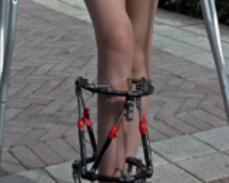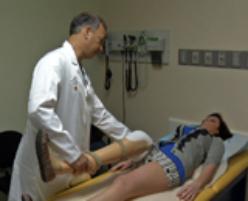
| DR. PALEY'S MEDIA SECTION |

Limb Lengthening.us
Dror Paley, MD, FRCSC
Dror Paley, MD, FRCSC
| ORTHOPEDIC EDUCATIONAL SITE BY THE MOST EXPERIENCED LIMB LENGTHENING SURGEON IN THE WORLD |
Imagine the doctors saying amputation is your only option. That's the reality for some kids born
with leg deformities. But, one doctor is working to give these children more choices.
Reporter: Melissa Medalie
Email Address: news@wctv.tv
Kelly Lockett doesn't miss a step when browsing for her next purchase even though this 13
year old has depended on one leg her entire life. Kelly was born with the bone behind her shin
missing. The condition deformed her foot and shortened her leg. Doctors told her mom that
amputation was the best option.
"We were told she would have psychological scars from all the surgeries and therefore we should
amputate," said Carolyn Lockett.
with leg deformities. But, one doctor is working to give these children more choices.
Reporter: Melissa Medalie
Email Address: news@wctv.tv
Kelly Lockett doesn't miss a step when browsing for her next purchase even though this 13
year old has depended on one leg her entire life. Kelly was born with the bone behind her shin
missing. The condition deformed her foot and shortened her leg. Doctors told her mom that
amputation was the best option.
"We were told she would have psychological scars from all the surgeries and therefore we should
amputate," said Carolyn Lockett.
| Lengthening Legs by 10 Inches March 16, 2010 |
Doctor Dror Paley has been working for 23 years to correct
limb deformities and injuries without amputation.
"Although it's more surgery, you end up with your own leg,"
said Dror Paley, M.D., F.R.C.S.C., Director, Paley Advanced
Limb Lengthening Institute.
He broke her shin bone and implanted a metal fixator, which is
worn for eight months and is designed to lengthen the bone
one millimeter a day.
limb deformities and injuries without amputation.
"Although it's more surgery, you end up with your own leg,"
said Dror Paley, M.D., F.R.C.S.C., Director, Paley Advanced
Limb Lengthening Institute.
He broke her shin bone and implanted a metal fixator, which is
worn for eight months and is designed to lengthen the bone
one millimeter a day.
"What's happening in the lengthening is every single day, you're pulling the bone apart. The
bone is a living substance. It makes new bone to fill in where you break it. You're pulling it apart
and it makes new bone to fill that gap," said Dr. Paley.
"During the lengthening, it was painful," Kelly said. "I've never thought, 'I don't wanna do this.'
There's never been a point where I've wanted to stop, because I just keep thinking of the end
and how it's going to be."
Kelly's leg is now 10 inches longer than it would have been without the surgeries.
Twenty-three-year-old Julie Nichols hopes for similar results.
"I never wanted to opt for amputation," Nichols told Ivanhoe. "It was never in my heart to do
that. I just knew that one day, maybe there would be another option for me."

She's in for three surgeries and almost a year of therapy,
but says her goal will keep her going.
"I want to run so bad," Nichols said. "After these surgeries,
my goal is to run a marathon."
Dr. Paley has performed over 10,000 limb lengthening
procedures and says he is one of three surgeons in the
United States who perform the more complicated surgeries
like Kelly's. Dr. Paley monitors the device's progress with
X-rays every two weeks and says he can slow down or
speed up the bone lengthening as needed.
but says her goal will keep her going.
"I want to run so bad," Nichols said. "After these surgeries,
my goal is to run a marathon."
Dr. Paley has performed over 10,000 limb lengthening
procedures and says he is one of three surgeons in the
United States who perform the more complicated surgeries
like Kelly's. Dr. Paley monitors the device's progress with
X-rays every two weeks and says he can slow down or
speed up the bone lengthening as needed.

BACKGROUND: One in 130 babies is born with a muscular or skeletal deformity, according to
the March of Dimes. These include some of the rarer defects of the leg like proximal focal
femoral deficiency (PFFD) and fibular hemimelia. PFFD is a rare congenital defect that slows the
development of the upper femur and hip joint. While severity differs by case, PFFD causes the
affected leg to be shorter than the other leg.
Treatment varies by case, but may include reconstruction of the hip joint. Most doctors only
recommend this type of treatment for mild cases. Fibular hemimelia happens when the smaller
bone of the lower leg - or the fibula - is completely missing. Babies may also be born with a
deformed foot. Most cases of fibular hemimelia occur for no known reason, according to an
article in Pregnancy Today. Some possible causes that have been identified include inheritance,
medications like insulin, or a traumatic event during the early weeks of gestation.
TREATMENT: The treatments for congenital limb deformities vary widely by case and include
the use of adaptive devices like prosthetics, orthotics and shoe lifts. For some patients,
surgeons recommend amputation of the foot in order to more effectively use a prosthetic. Some
procedures to lengthen legs affected by a deformity are done on an outpatient basis and involve
small incisions. Other procedures are more involved and require the use of an external device
attached to the limb with pins and wires. The device may be worn for months to lengthen the
limb over the long-term.
Dror Paley, M.D., director of the Paley Advanced Limb Lengthening Institute at St. Mary's Medical
Center in West Palm Beach, Fla., corrects severe cases of limb deformity through multiple
surgeries and special lengthening devices. He first performs surgery to correct the joints
involved, including the hip, knee and/or ankle. In a separate procedure, he breaks the bone that
requires lengthening and attached an external "fixator" using wires or screws. That device is
worn for up to eight months and is adjusted by the patient each day with a wrench. "It's like a
scaffold: It supports the internal structure of the bone until the bone reconstructs itself," Dr.
Paley told Ivanhoe.
Patients come in regularly for X-rays to track the affected bone's progress and undergo intense
physical therapy throughout the lengthening process. Dr. Paley said after doing psychological
evaluation on a group of patients undergoing limb lengthening and compared the results to
patients who underwent amputation, he found no adverse psychological affects in the limb
lengthening patients.
For more information, please contact:
Paley Advanced Limb Lengthening Institute
(561) 844-5255
Caroline Eaton, Program Coordinator
ceaton@lengthening.us
the March of Dimes. These include some of the rarer defects of the leg like proximal focal
femoral deficiency (PFFD) and fibular hemimelia. PFFD is a rare congenital defect that slows the
development of the upper femur and hip joint. While severity differs by case, PFFD causes the
affected leg to be shorter than the other leg.
Treatment varies by case, but may include reconstruction of the hip joint. Most doctors only
recommend this type of treatment for mild cases. Fibular hemimelia happens when the smaller
bone of the lower leg - or the fibula - is completely missing. Babies may also be born with a
deformed foot. Most cases of fibular hemimelia occur for no known reason, according to an
article in Pregnancy Today. Some possible causes that have been identified include inheritance,
medications like insulin, or a traumatic event during the early weeks of gestation.
TREATMENT: The treatments for congenital limb deformities vary widely by case and include
the use of adaptive devices like prosthetics, orthotics and shoe lifts. For some patients,
surgeons recommend amputation of the foot in order to more effectively use a prosthetic. Some
procedures to lengthen legs affected by a deformity are done on an outpatient basis and involve
small incisions. Other procedures are more involved and require the use of an external device
attached to the limb with pins and wires. The device may be worn for months to lengthen the
limb over the long-term.
Dror Paley, M.D., director of the Paley Advanced Limb Lengthening Institute at St. Mary's Medical
Center in West Palm Beach, Fla., corrects severe cases of limb deformity through multiple
surgeries and special lengthening devices. He first performs surgery to correct the joints
involved, including the hip, knee and/or ankle. In a separate procedure, he breaks the bone that
requires lengthening and attached an external "fixator" using wires or screws. That device is
worn for up to eight months and is adjusted by the patient each day with a wrench. "It's like a
scaffold: It supports the internal structure of the bone until the bone reconstructs itself," Dr.
Paley told Ivanhoe.
Patients come in regularly for X-rays to track the affected bone's progress and undergo intense
physical therapy throughout the lengthening process. Dr. Paley said after doing psychological
evaluation on a group of patients undergoing limb lengthening and compared the results to
patients who underwent amputation, he found no adverse psychological affects in the limb
lengthening patients.
For more information, please contact:
Paley Advanced Limb Lengthening Institute
(561) 844-5255
Caroline Eaton, Program Coordinator
ceaton@lengthening.us

The news video may take a few minutes to load
